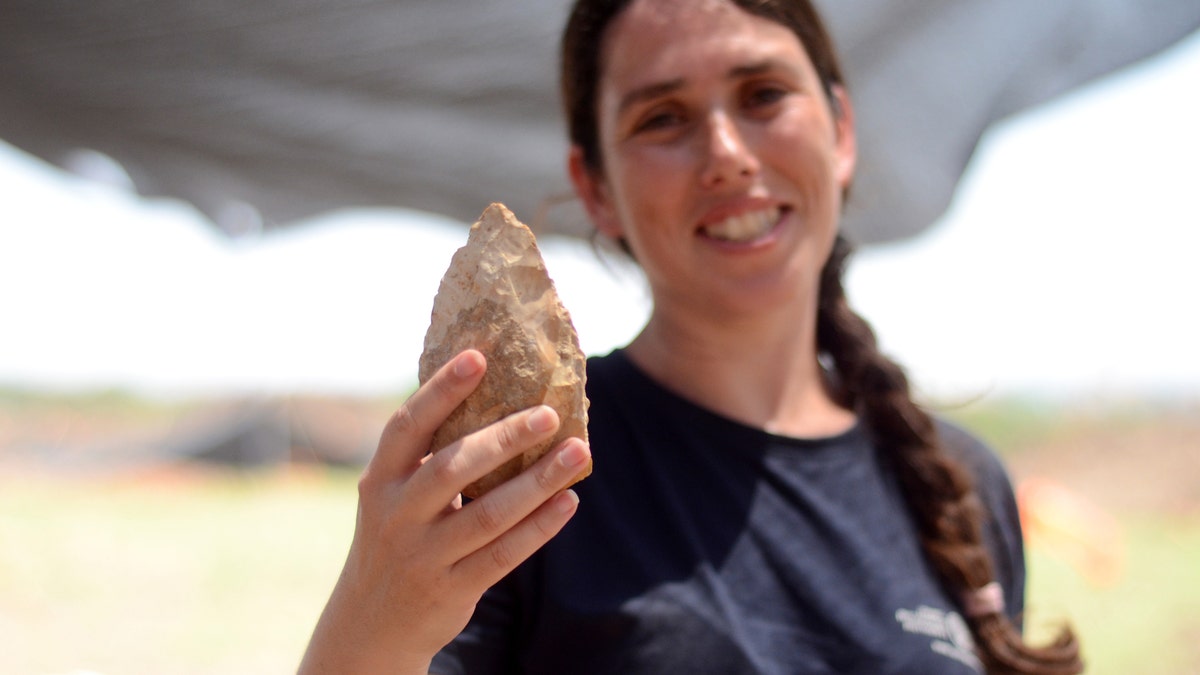
Hundreds of hand axes were uncovered in the excavation. (Samuel Magal, Courtesy of the Israel Antiquities Authority)
Archaeologists in Israel have uncovered a prehistoric ‘paradise’ dating back half a million years.
Experts from the Israel Antiquities Authority and Tel Aviv University have been excavating the site at Jaljulia in Central Israel in recent months, unearthing hundreds of flint hand axes.
“The site of Jaljulia is unique and very special,” explained Professor Ron Barkai, head of the archaeology department at Tel Aviv University, in a video posted to YouTube. “It was used by people half a million years ago, it was covered rapidly by sediment – nobody knew that it was here.”
ANCIENT PLANTS IN ISRAEL GIVE CLUES ABOUT REAL 'PALEO' DIET
Archaeologists say that the site, which is on the banks of an ancient stream (now flowing about a third of a mile to the south), was rich in vegetation and herding animals. In a statement, Barkai and Maayan Shemer, who directed the excavation on behalf of the Israel Antiquities authority, described the site as a “green spot” in the landscape.

The excavation at Jaljulia. (Samuel Magal, Courtesy of the Israel Antiquities Authority)
The excavation offers a fascinating glimpse into the lives of prehistoric humans living during the Lower Paleolithic period. Specifically, the haul of teardrop-shaped flint hand axes is evidence of activity by Homo Erectus, a direct ancestor of modern humans.
“A river was running here, running from East to West, bringing with it a lot of flint nodules,” explained Barkai, noting that the nodules were used to create flint tools and butcher animals. “Animals came here because of the water, so for people it was like a paradise, so they came here again and again.”
RESEARCHERS FIND 300,000-YEAR-OLD HEARTH IN ISRAEL
“The findings are amazing, both in their preservation state and in their implications about our understanding of this ancient material culture,” Shemer added in the statement. “We see here a wide technological variety, and there is no doubt that researching these finds in-depth will contribute greatly to the understanding of the lifestyle and human behavior during the period in which Homo Erectus inhabited our area.”

Maayan Shemer, excavation director for the Israel Antiquities Authority, showing a half-million year-old hand axe. (Samuel Magal, Courtesy of the Israel Antiquities Authority)
The discovery is the latest fascinating prehistoric find in Israel. In 2016, experts found the remains of 780,000-year-old edible plants, shedding light on the diet of early humans.
DRONE FINDS MYSTERIOUS ANCIENT STRUCTURE ATISRAELI MILITARY TRAINING GROUND
In 2014, a 300,000-year-old hearth was discovered in the Qesem Cave near the town of Rosh Ha’ayin in Central Israel. The Qesem Cave is about 3 miles to the south of the Jaljulia excavation site.
Follow James Rogers on Twitter @jamesjrogers
